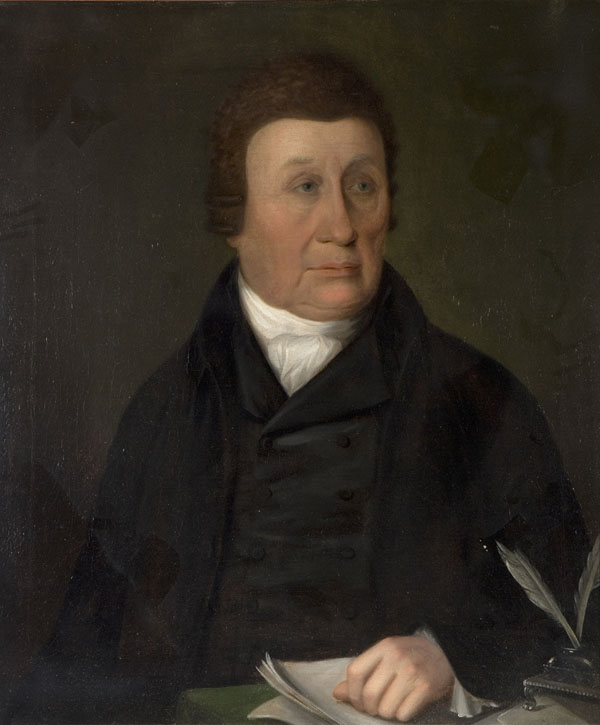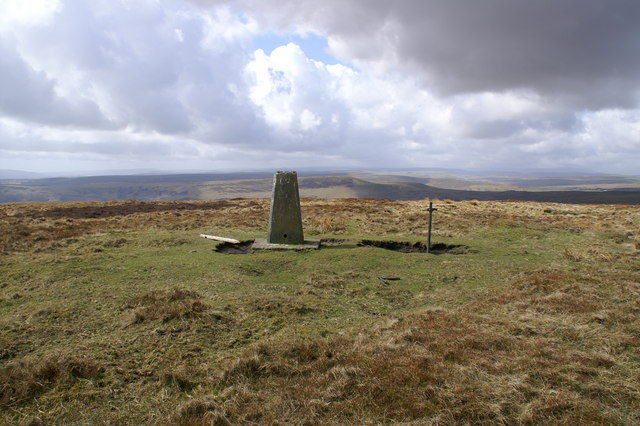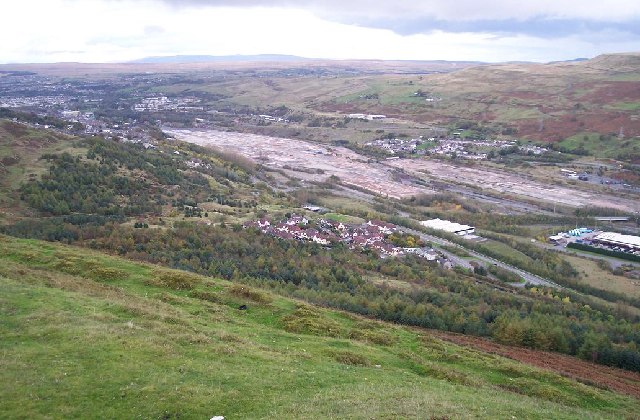|
Jeremiah Homfray
Sir Jeremiah Homfray (16 February 1759 – 9 January 1833) was an English ironmaster, best known for mineral developments in South Wales for and starting the Ebbw Vale ironworks. Early life The third son of Francis Homfray of Stourton Castle, joint owner with his younger brothers (Thomas and Samuel) of the Penydarren Ironworks. On the death of his father, he was made co-owner and joint Managing Director of the ironworks with his brother Samuel Homfray, M.P., of Coworth Park, Berkshire. In 1787, he married Mary, the daughter of John Richards, of Llandaff, and after this for many years resided at Llandaff House. Ebbw Vale Ironworks In 1789, Walter Watkins was the owner of a forge at the Clydach Ironworks in Glangrwney, Clydach Vale near Crickhowell, which lacked an adequate supply of pig iron. In agreement with two business partners, his son-in-law Charles Cracroft and Jeremiah Homfray, the three leased land at Pen y cae farm in the parish of Aberystruth from John Miles. ... [...More Info...] [...Related Items...] OR: [Wikipedia] [Google] [Baidu] |
Ironmaster
An ironmaster is the manager, and usually owner, of a forge or blast furnace for the processing of iron. It is a term mainly associated with the period of the Industrial Revolution, especially in Great Britain. The ironmaster was usually a large scale entrepreneur and thus an important member of a community. He would have a large country house or mansion as his residence. The organization of operations surrounding the smelting, refining and casting of iron was labour-intensive, and so there would be numerous workers reliant on the furnace works. There were ironmasters (possibly not called such) from the 17th century onwards, but they became more prominent with the great expansion in the British iron industry during the Industrial Revolution. 17th century ironmasters (examples) An early ironmaster was John Winter (Royalist), John Winter (about 1600–1676) who owned substantial holdings in the Forest of Dean. During the English Civil War he cast cannons for Charles I of England ... [...More Info...] [...Related Items...] OR: [Wikipedia] [Google] [Baidu] |
Aberystruth
Aberystruth was an ancient ecclesiastical parish in Wales, located beside the north-west corner of the county of Monmouthshire against the border with Breconshire and between the parishes of Bedwellty and Trevethin. It extended from Beaufort in the north beyond Abertillery in the south. Blaina The parish church located near the centre of the parish in the village of Blaina and dedicated to St Peter, was first built about the year 1500 and that building lasted more than 320 years. Following a fire which destroyed the original St Peter's another church was built on the site, the opening services being held on 4 December 1856; this was demolished in 1966. The present St Peter's Blaina dates from the late 1960s and today forms part of a larger ministry area served by clergy headed by the Rector of Ebbw Vale. Aberystruth remained the official ecclesiastical name of the parish into the 1980s. Clergy were styled Rector of Aberystruth (Blaina) in Crockford's Clerical Directory but it ... [...More Info...] [...Related Items...] OR: [Wikipedia] [Google] [Baidu] |
Abernant, Rhondda Cynon Taf
Abernant (or Abernant-y-Wenallt) is a small village north-east of the town of Aberdare, Rhondda Cynon Taf, Wales. Like many in the South Wales Valleys, it was once a coal-mining village. Etymology Abernant is a shortening of the name "Abernant-y-Wenallt", and the area is recorded under this name in an 1800 lease of the land. While the place-name element ''Aber'' is easily understand as a confluence of watercourses, (here referring to meeting of the Nant y Wenallt and the Cynon) the rest of the name is more debatable. The element ''-wen'' may refer to the colour white, or as an indicator that the place was in some way "blessed" or "holy". Similarly, the termination ''-allt'' commonly refers to an area of sloping hillside but can also denote an the area as heavily wooded. Finally, In the language of South East Wales, ''nant'' refers to the watercourse itself, rather than the valley it sits in, therefore the name may be translated as either "the mouth of the white brook on the woo ... [...More Info...] [...Related Items...] OR: [Wikipedia] [Google] [Baidu] |
Annuity (finance Theory)
In investment, an annuity is a series of payments made at equal intervals.Kellison, Stephen G. (1970). ''The Theory of Interest''. Homewood, Illinois: Richard D. Irwin, Inc. p. 45 Examples of annuities are regular deposits to a savings account, monthly home mortgage payments, monthly insurance payments and pension payments. Annuities can be classified by the frequency of payment dates. The payments (deposits) may be made weekly, monthly, quarterly, yearly, or at any other regular interval of time. Annuities may be calculated by mathematical functions known as "annuity functions". An annuity which provides for payments for the remainder of a person's lifetime is a life annuity. Types Annuities may be classified in several ways. Timing of payments Payments of an ''annuity-immediate'' are made at the end of payment periods, so that interest accrues between the issue of the annuity and the first payment. Payments of an ''annuity-due'' are made at the beginning of payment periods ... [...More Info...] [...Related Items...] OR: [Wikipedia] [Google] [Baidu] |
Quaker
Quakers are people who belong to a historically Protestant Christian set of Christian denomination, denominations known formally as the Religious Society of Friends. Members of these movements ("theFriends") are generally united by a belief in each human's ability to experience Inward light, the light within or see "that of God in every one". Some profess a priesthood of all believers inspired by the First Epistle of Peter. They include those with evangelicalism, evangelical, Holiness movement, holiness, Mainline Protestant, liberal, and Conservative Friends, traditional Quaker understandings of Christianity. There are also Nontheist Quakers, whose spiritual practice does not rely on the existence of God. To differing extents, the Friends avoid creeds and Hierarchical structure, hierarchical structures. In 2017, there were an estimated 377,557 adult Quakers, 49% of them in Africa. Some 89% of Quakers worldwide belong to ''evangelical'' and ''programmed'' branches that hold ... [...More Info...] [...Related Items...] OR: [Wikipedia] [Google] [Baidu] |
Bristol
Bristol () is a city, ceremonial county and unitary authority in England. Situated on the River Avon, it is bordered by the ceremonial counties of Gloucestershire to the north and Somerset to the south. Bristol is the most populous city in South West England. The wider Bristol Built-up Area is the eleventh most populous urban area in the United Kingdom. Iron Age hillforts and Roman villas were built near the confluence of the rivers Frome and Avon. Around the beginning of the 11th century, the settlement was known as (Old English: 'the place at the bridge'). Bristol received a royal charter in 1155 and was historically divided between Gloucestershire and Somerset until 1373 when it became a county corporate. From the 13th to the 18th century, Bristol was among the top three English cities, after London, in tax receipts. A major port, Bristol was a starting place for early voyages of exploration to the New World. On a ship out of Bristol in 1497, John Cabot, a Venetia ... [...More Info...] [...Related Items...] OR: [Wikipedia] [Google] [Baidu] |
Ebbw Vale Steelworks
Ebbw Vale Steelworks was an integrated steel mill located in Ebbw Vale, South Wales. Developed from 1790, by the late 1930s it had become the largest steel mill in Europe. Nationalized after World War II, as the steel industry changed to bulk handling, iron and steel making was ceased in the 1970s, as the site was redeveloped as a specialised tinplate works. Closed by Corus in 2002, the site is being redeveloped in a joint-partnership between Blaenau Gwent Council and the Welsh Government. Development By the mid to late 1700s, the steep-sided wooded valley of the Ebbw Fawr river was called home by a population of around 120, who worked the valley as farmers. But the valley was about to transformed by the Industrial Revolution, by the building of what became Europe's largest steel mill. In 1789, Walter Watkins was the owner of a forge in Glangrwney, near Crickhowell, which lacked an adequate supply of pig iron from the Clydach Ironworks. In agreement with two business partners, ... [...More Info...] [...Related Items...] OR: [Wikipedia] [Google] [Baidu] |
Blast Furnace
A blast furnace is a type of metallurgical furnace used for smelting to produce industrial metals, generally pig iron, but also others such as lead or copper. ''Blast'' refers to the combustion air being "forced" or supplied above atmospheric pressure. In a blast furnace, fuel ( coke), ores, and flux (limestone) are continuously supplied through the top of the furnace, while a hot blast of air (sometimes with oxygen enrichment) is blown into the lower section of the furnace through a series of pipes called tuyeres, so that the chemical reactions take place throughout the furnace as the material falls downward. The end products are usually molten metal and slag phases tapped from the bottom, and waste gases (flue gas) exiting from the top of the furnace. The downward flow of the ore along with the flux in contact with an upflow of hot, carbon monoxide-rich combustion gases is a countercurrent exchange and chemical reaction process. In contrast, air furnaces (such as reverbera ... [...More Info...] [...Related Items...] OR: [Wikipedia] [Google] [Baidu] |
Blaenavon
Blaenavon ( cy, Blaenafon) is a town and community (Wales), community in Torfaen county borough, Wales, high on a hillside on the source of the Afon Lwyd. It is within the boundaries of the historic county of Monmouthshire (historic), Monmouthshire and the Preserved counties of Wales, preserved county of Gwent (county), Gwent. The population is 6,055. Parts of the town and surrounding country form the Blaenavon Industrial Landscape, inscribed as a World Heritage Site by UNESCO in 2000. History ''Blaenavon'' literally means "head of the river" or loosely "river's source" in the Welsh language. Blaenavon grew around an ironworks opened in 1788 by the West Midlands (region), West Midlands industrialist, Thomas Hill of Dennis, Thomas Hill, and his partners, Thomas Hopkins and Benjamin Pratt. The businessmen invested £40,000 into the iron works project and erected three blast furnaces. Hopkins, as a result of operating the Cannock Wood Forge in Rugeley, Staffordshire, was in ... [...More Info...] [...Related Items...] OR: [Wikipedia] [Google] [Baidu] |
Mule
The mule is a domestic equine hybrid between a donkey and a horse. It is the offspring of a male donkey (a jack) and a female horse (a mare). The horse and the donkey are different species, with different numbers of chromosomes; of the two possible first-generation hybrids between them, the mule is easier to obtain and more common than the hinny, which is the offspring of a female donkey (a jenny) and a male horse (a stallion). Mules vary widely in size, and may be of any color. They are more patient, hardier and longer-lived than horses, and are perceived as less obstinate and more intelligent than donkeys. Terminology A female mule that has oestrus cycles, and which could thus in theory carry a foetus, is called a "molly" or "Molly mule", though the term is sometimes used to refer to female mules in general. A male mule is properly called a "horse mule", though often called a "john mule", which is the correct term for a gelded mule. A young male mule is called a "mule co ... [...More Info...] [...Related Items...] OR: [Wikipedia] [Google] [Baidu] |
Limestone
Limestone ( calcium carbonate ) is a type of carbonate sedimentary rock which is the main source of the material lime. It is composed mostly of the minerals calcite and aragonite, which are different crystal forms of . Limestone forms when these minerals precipitate out of water containing dissolved calcium. This can take place through both biological and nonbiological processes, though biological processes, such as the accumulation of corals and shells in the sea, have likely been more important for the last 540 million years. Limestone often contains fossils which provide scientists with information on ancient environments and on the evolution of life. About 20% to 25% of sedimentary rock is carbonate rock, and most of this is limestone. The remaining carbonate rock is mostly dolomite, a closely related rock, which contains a high percentage of the mineral dolomite, . ''Magnesian limestone'' is an obsolete and poorly-defined term used variously for dolomite, for limes ... [...More Info...] [...Related Items...] OR: [Wikipedia] [Google] [Baidu] |
River
A river is a natural flowing watercourse, usually freshwater, flowing towards an ocean, sea, lake or another river. In some cases, a river flows into the ground and becomes dry at the end of its course without reaching another body of water. Small rivers can be referred to using names such as Stream#Creek, creek, Stream#Brook, brook, rivulet, and rill. There are no official definitions for the generic term river as applied to Geographical feature, geographic features, although in some countries or communities a stream is defined by its size. Many names for small rivers are specific to geographic location; examples are "run" in some parts of the United States, "Burn (landform), burn" in Scotland and northeast England, and "beck" in northern England. Sometimes a river is defined as being larger than a creek, but not always: the language is vague. Rivers are part of the water cycle. Water generally collects in a river from Precipitation (meteorology), precipitation through a ... [...More Info...] [...Related Items...] OR: [Wikipedia] [Google] [Baidu] |







